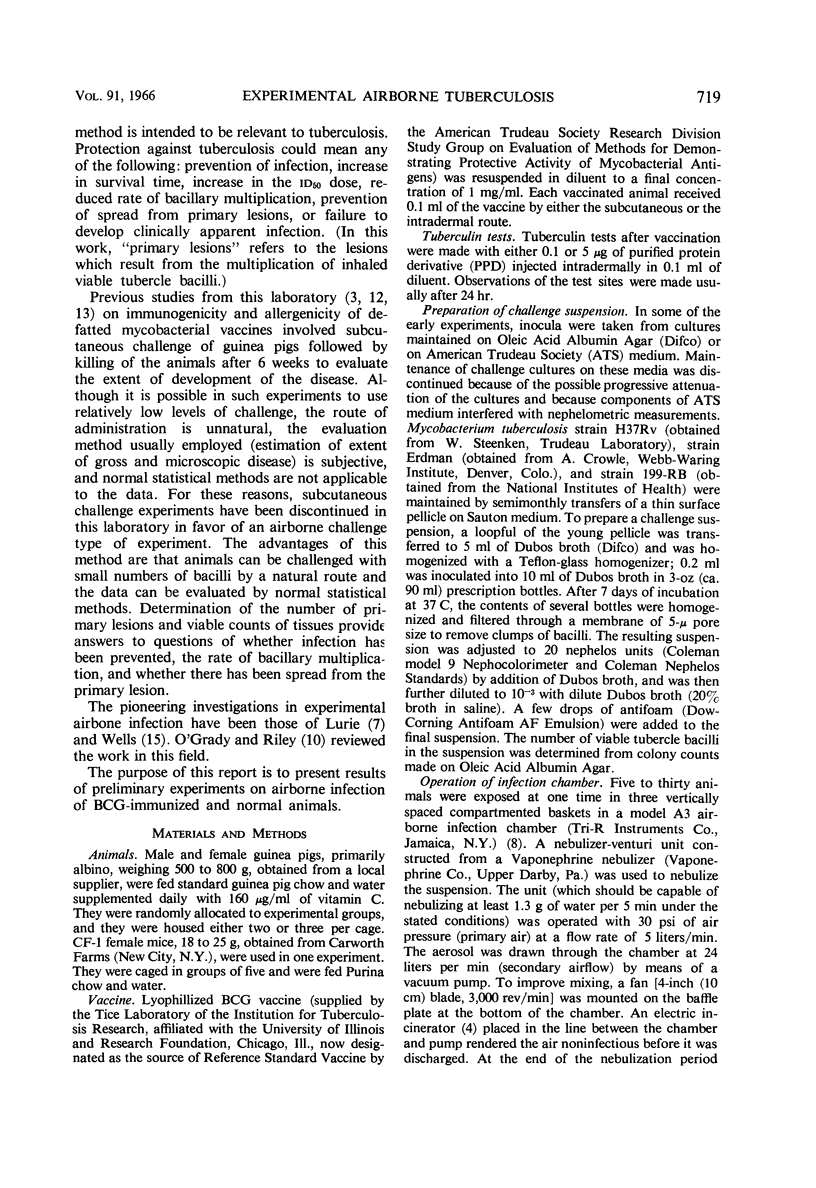Abstract
Smith, D. W. (University of Wisconsin, Madison), E. Wiegeshaus, R. Navalkar, and A. A. Grover. Host-parasite relationships in experimental airborne tuberculosis. I. Preliminary studies in BCG-vaccinated and nonvaccinated animals. J. Bacteriol. 91:718–724. 1966.—Previous studies from this laboratory on immunogenicity and allergenicity of defatted mycobacterial vaccines involved subcutaneous challenge of guinea pigs and killing of the animals 6 weeks later to evaluate the amount of disease. This type of experiment has discontinued in this laboratory in favor of an airborne challenge type of experiment, with the advantages that animals can be challenged with small numbers of bacilli by a natural route, and the number of primary lesions, the rate of spread from those lesions, and the rate of bacillary multiplication can be used to evaluate protection. Experiments to determine uniformity of infection showed that a fair degree of uniformity resulted when seven guinea pigs were exposed simultaneously, and were studied 3 weeks later to determine numbers of primary lesions and bacilli in the tissues. A less satisfactory degree of uniformity was obtained when more animals were exposed at one time. BCG-vaccinated and nonvaccinated animals were studied to determine the earliest time and the optimal time for killing the animals to detect the effects of vaccination. In guinea pigs, the degree of protection assessed by lesion counts is time-dependent, but the degree of protection assessed by viable counts of bacilli in the tissues was relatively constant 3 to 12 weeks after infection. Mice vaccinated subcutaneously with BCG were not protected against infection at any interval between 2 and 19 weeks. Guinea pigs vaccinated subcutaneously with the same lot of vaccine were protected as judged by counts of viable bacilli in the tissues 3 weeks after infection.
Full text
PDF






Images in this article
Selected References
These references are in PubMed. This may not be the complete list of references from this article.
- CROWLE A. J. Immunizing constituents of the tubercle bacillus. Bacteriol Rev. 1958 Sep;22(3):183–203. doi: 10.1128/br.22.3.183-203.1958. [DOI] [PMC free article] [PubMed] [Google Scholar]
- FENNER F. The enumeration of viable tubercle bacilli by surface plate counts. Am Rev Tuberc. 1951 Oct;64(4):353–380. doi: 10.1164/art.1951.64.4.353. [DOI] [PubMed] [Google Scholar]
- FREGNAN G. B., SMITH D. W. Immunogenicity and allergenioity in guinea pigs of a defatted mycobacterial vaccine and its fractions. Am Rev Respir Dis. 1963 Jun;87:877–888. doi: 10.1164/arrd.1963.87.6.877. [DOI] [PubMed] [Google Scholar]
- GREMILLION G. G., MILLER L. F., BODMER G. A. An electric incinerator for sterilization of small volumes of air. Appl Microbiol. 1958 Jul;6(4):274–276. doi: 10.1128/am.6.4.274-276.1958. [DOI] [PMC free article] [PubMed] [Google Scholar]
- GUYTON H. G., DECKER H. M. Respiratory protection provided by five new contagion masks. Appl Microbiol. 1963 Jan;11:66–68. doi: 10.1128/am.11.1.66-68.1963. [DOI] [PMC free article] [PubMed] [Google Scholar]
- LARSON C. L., WICHT W. C. Studies of resistance to experimental tuberculosis in mice vaccinated with living attenuated tubercle bacilli and challenged with virulent organisms. Am Rev Respir Dis. 1962 Jun;85:833–846. doi: 10.1164/arrd.1962.85.6.833. [DOI] [PubMed] [Google Scholar]
- MIDDLEBROOK G. An apparatus for airborne infection of mice. Proc Soc Exp Biol Med. 1952 May;80(1):105–110. doi: 10.3181/00379727-80-19538. [DOI] [PubMed] [Google Scholar]
- MIDDLEBROOK G. Immunological aspects of airborne infection: reactions to inhaled antigens. Bacteriol Rev. 1961 Sep;25:331–346. doi: 10.1128/br.25.3.331-346.1961. [DOI] [PMC free article] [PubMed] [Google Scholar]
- RIBI E., LARSON C. L., WICHT W., LIST R., GOODE G. RESISTANCE TO EXPERIMENTAL TUBERCULOSIS STIMULATED BY FRACTIONS FROM ATTENUATED TUBERCLE BACILLI. Proc Soc Exp Biol Med. 1965 Apr;118:926–933. doi: 10.3181/00379727-118-30009. [DOI] [PubMed] [Google Scholar]
- SMITH D. W., FREGNAN G. B., DELAQUERRIERE L., VALDIVIA E. INDUCTION OF ACQUIRED RESISTANCE IN GUINEA PIGS WITH DEFATTED MYCOBACTERIUM TUBERCULOSIS VACCINES. J Bacteriol. 1964 Jul;88:87–92. doi: 10.1128/jb.88.1.87-92.1964. [DOI] [PMC free article] [PubMed] [Google Scholar]
- SMITH D. W., KUBICA G. P. Comparison of extracts of tubercle bacilli and BCG as immunizing agents in guinea pigs. Proc Soc Exp Biol Med. 1955 Dec;90(3):629–635. doi: 10.3181/00379727-90-22118. [DOI] [PubMed] [Google Scholar]
- WEISS D. W. Vaccination against tuberculosis with nonliving vaccines. I. The problem and its historical background. Am Rev Respir Dis. 1959 Sep;80:340–358. doi: 10.1164/arrd.1959.80.3.340. [DOI] [PubMed] [Google Scholar]




